December 21, 2009
Feinstein Introduces "Mojave Trails National Monument" Bill
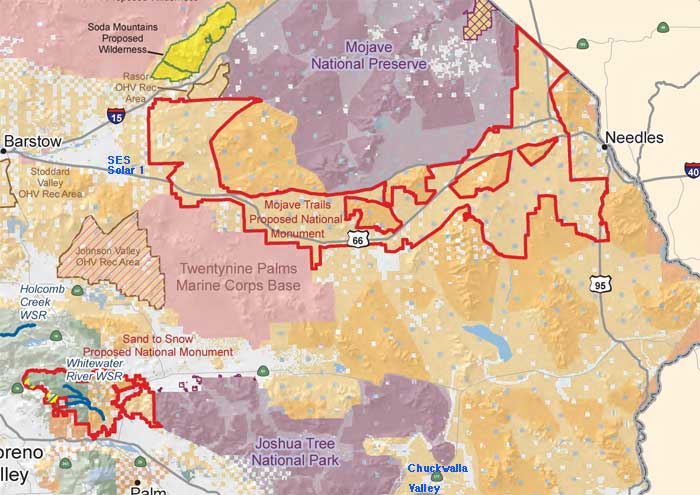
Senator Dianne Feinstein (D-California) says she plans to introduce legislation today to establish two national monuments on almost 1 million acres of Mojave Desert along old Route 66. (See our story >>here)
Mojave Trails National Monument would cover 941,000 acres of federal land and former railroad company property along a 105-mile between Ludlow and Needles. But it would leave out other vast sections of the Colorado Desert, such as Chuckwalla Valley, open to energy developers.
The smaller Sand to Snow National Monument, about 45 miles east of Riverside, would cover about 134,000 acres of federal land between Joshua Tree National Park and the San Bernardino National Forest in San Bernardino and Riverside counties. It would range from desert scrub to Ponderosa pine forests 9,000 feet above sea level.
The legislation, which had been delayed by efforts to resolve conflicts among environmentalists, off-roaders and renewable energy interests, would also designate 250,000 acres of public land near the Army's training center at Ft. Irwin as wilderness; add 41,000 acres to the southern boundary of Death Valley National Park and add 2,900 acres to northern portions of Joshua Tree National Park.
In addition, it would designate as permanent five existing off-highway vehicle areas in San Bernardino County covering 314,000 acres.
The legislation could be approved by late 2010.
"This magnificent land and its lonely beauty are a significant part of our history, and we shouldn't give it up," Feinstein said, adding that private donors helped acquire the former railroad parcels "with the belief they would be protected from development. We have an obligation to keep them that way."
The railroad land was purchased between 1999 and 2003 with $45 million in private donations collected by the nonprofit Wildlands Conservancy and $18 million in federal funds, then donated to the Department of the Interior.
The Bureau of Land Management is reviewing 130 applications for solar and wind-energy development in the California desert, covering more than 1 million acres of public land. At least 19 projects would lie in the proposed monument.
Feinstein's bill would assist companies with projects currently proposed inside monument boundaries to relocate to federal energy zones being developed elsewhere. Solar Energy Study Areas are not affected. Proposed projects such as SES Solar 1 in a Solar Energy Study Area would lie right on the western edge of the monument (see map).
It would also permit construction of transmission lines within existing utility rights of way to facilitate the transfer of renewable energy generated in the Southern California desert and adjacent states.
In an effort to avoid conflicts, BrightSource Energy Inc. and Stirling Energy Systems recently scrapped plans to build massive solar and wind farms on a panoramic stretch of the proposed Mojave Trails monument known as Sleeping Beauty Valley (Broadwell Dry Lake basin). Stirling Energy Systems is still forging ahead with a massive 8,000-acre SunCatcher dish farm on pristine desert on the other side of the Cady Mountains to the west, however.
Story in the Los Angeles Times >>here. See also The Wilderness Society press release.
See the story in the New York Times >>here.
Chris Clarke placed the bill on his website as a pdf >>here.
Outline of the California Desert Protection Act of 2010:
The conservation and recreation portion of the California Desert Protection Act of 2010 (specifically, Title I of the legislation) will improve protection for 1,602,904 acres of federal land. Specifically, it will:
• Establish the 941,413-acre Mojave Trails National Monument in eastern San Bernardino County along the southern boundary of the Mojave National Monument;
• Designate the 133,524-acre Sand to Snow National Monument that stretches between Joshua Tree National Park on the east and the highcountry of the San Gorgonio Wilderness in the San Bernardino National Forest to the west;
• Add three areas encompassing 173,861 acres to the National Wilderness Preservation System, including the Avawatz Mountains Wilderness (86,614 acres), Great Falls Basin Wilderness (7,871 acres) and Soda Mountains Wilderness (79,376 acres);
• Enlarge four existing wilderness areas by 172,247 acres, including the Death Valley National Park Wilderness (90,152 acres), Golden Valley Wilderness (21,633 acres), Kingston Range Wilderness (53,321 acres) and San Gorgonio Wilderness (7,141 acres);
• Establish the 75,575-acre Vinagre Wash Special Management Area in Imperial County where many ecologically and culturally sensitive areas would be protected from development and vehicle use, including 48,699 acres that would essentially be managed as wilderness;
• Enlarge Death Valley National Park by 40,740 acres, Mojave National Preserve by 29,246 acres and Joshua Tree National Park by 2,904 acres;
• Add over 70 miles (22,400 acres) of stream to the National Wild and Scenic Rivers System along the Amargosa River, Deep Creek, Surprise Canyon and the Whitewater River;
• Permanently prohibit the staking of new mining claims on approximately 10,000 acres of land sacred to the Quechan Tribe in Imperial County;
• Mandate the study and protection of a cultural trail and the features associated with it along the Colorado River that is sacred to several tribes;
• Make it more difficult for developers to excessively exploit groundwater in or near the Mojave National Preserve;
• Transfer a 994-acre Bureau of Land Management holding in San Diego County to Anza-Borrego Desert State Park and require the state to manage the land as wilderness;
• Protect land from development that has been donated to or acquired by the federal government for conservation purposes (in most cases);
• Require the Department of the Interior to study the future impacts of climate change on the California desert, to mitigate these impacts and to identify and protect important wildlife migration corridors in the region.
In addition to these protective measures, as a political compromise Title I will also:
• Withdraw protection from 33,571 acres of the Soda Mountains Wilderness Study Area;
• Withdraw protection from the 84,400-acre Cady Mountains Wilderness Study Area (however, all but 5,500 acres of the area will be included in the Mojave Trails National Monument); also Great Falls Basin Wilderness Study Area would be "released."
• Facilitate the transfer of isolated parcels of state-owned land that are surrounded by desert wilderness areas and parks in exchange for federal assets, potentially including parcels of federal land;
• Turn five existing administratively-designated off-highway vehicle (OHV) recreation areas into legislatively-designated OHV areas, and study the feasibility of expanding them (Stoddard, Johnson Valley, El Mirage, Rasor, Spangler);
• Allow for the expansion of a small airport in Imperial County.
More goodies: New right-of-ways may be allowed within the Monument to provide vehicular access to renewable energy project sites outside the boundaries of the Monument, the bill says. "Applicants for rights-of-way for the development of solar energy facilities that have been terminated by the establishment of the Monument shall be granted the right of first refusal to apply for replacement sites..." The bill goes on -- "Nothing in this section alters, affects, or displaces primary rights-of-way applications within the Solar Energy Study Areas..." (This means SES Solar 1 will continue.)
Impacts of climate change on the Conservation Area will be studied, and somewhat ironically, "policies and procedures to ensure the preservation of wildlife corridors and facilitate species migration likely to occur due to climate change will be implemented. But see below (studies show renewable energy developments are precisely what will block these migration corridors).
Limited exceptions to prohibited uses of donated land or acquired land in the Conservation Area may be authorized if an applicant has submitted a right-of-way use application to the Bureau of Land Management proposing renewable energy development on the donated land or acquired land on or before December 1, 2009. This apparently means the Catellus lands within SES Solar 1 may be built upon after all.
‘‘The Director of the Bureau of Land Management shall not access or process any application for a right-of-way for development projects that propose to use native
groundwater from aquifers adjacent to the Mojave National Preserve that individually or collectively, in combination with proposed or anticipated projects on private land, require the use of native groundwater in excess of the estimated recharge rate as determined by the United States Geological Survey.’’ One could argue that this might apply to the Ivanpah solar projects that are next to Clark Mountain.
DESERT RENEWABLE ENERGY PERMITTING: Renewable Energy Coordination Offices and new personell will be funded for Arizona, California, Colorado, Idaho, New Mexico, Nevada, Montana, Oregon, Utah, Wyoming.
The bill would address processes for improving renewable energy project review, including
timelines for environmental review, "clear channels of communication within and between departments, agencies, and States, and processes for facilitating, siting, and permitting of renewable energy projects consistent with Federal and State climate and renewable energy policy objectives.
A programmatic environmental impact statement in accordance with the National En-
vironmental Policy Act of 1969 would be developed.
A single multiagency, joint process under which renewable energy projects are reviewed and approved, would be funded. The income from solar and wind energy development collected by the Bureau of Land Management through would be redistributed: 25 percent shall be paid by the Secretary of the Treasury to the 1 or more States within the boundaries of which the income is derived; in the case of each of fiscal years 2009 through 2020, 25 percent shall be paid by the Secretary of the Treasury to the 1 or more counties within which the income is derived; 40 percent shall be deposited in a special fund in the Treasury, to be known as the ‘BLM Permit Processing Improvement Fund’; the coordination and processing of oil and gas use authorizations on onshore Federal land will continue. A Mitigation Bank Program would be established to help establish habitat conservation plans, permits, and consulations under the Endangered Species Act of 1973.
MITIGATION ZONE: 10 percent of land lease fees for public lands would be deposited in a special fund in the Treasury, to be known as the ‘Solar Energy Land Reclamation, Restoration, and Mitigation Fund’. This would be used to mitigate "impacts of the production on public land, including protecting other sensitive public land if the land used for solar or wind power generation cannot be adequately restored without the use of funds made available under this paragraph, as determined by the Secretary.
HABITAT MITIGATION ZONES: Federal or non-Federal lands that are "high conflict areas’’ in which conflicts between renewable energy development and the conservation of natural resources, including critical habitat, wildlife corridors, wetland, and other important environmental attributes, or other cultural resources are likely to be comparatively high. This would be part of a "coordinated method to mitigate the impact of qualified renewable energy projects on endangered or threatened species and the habitat of the species" (p. 149). The process would identify not less than 200,000 acres of eligible land for use as potential mitigation zones that the Secretary may establish and make available to mitigate
the impacts of qualified renewable energy projects on endangered or threatened species.
CALIFORNIA DESERT MITIGATION BANK PILOT PROGRAM: For fiscal years 2010 through 2015, the Secretary shall establish and administer a program to be known as the ‘‘California Desert Mitigation Bank Pilot Program’’ under which parcels of land identified as potential mitigation zones shall be made available to serve as mitigation, in accordance
with the Endangered Species Act of 1973 for the development of renewable energy projects on parcels of non-Federal land that are located in the California Desert Conservation Area.
CALIFORNIA DESERT MITIGATION FUND: "The Secretary may enter into an agreement with an organization that promotes fish and wildlife conservation to accept, receive, hold, transfer, solicit, and administer funds received or made available, including funds received in the form of a gift or donation, for a ‘‘California Desert Mitigation Fund’’ under this Act the purpose of which is to provide resources for administration of the mitigation zones authorized by this section." (p. 157) The Interior Secretary retains final authority for determining what amounts will be disbursed from the Fund. In the fund would go monetary contributions and donated funds from individuals and public or private organizations, and permitting fees. Acquisition of interests in non-Federal land would be a use for the fund. Amounts from the Fund would be used to carry out the following activities in mitigation zones for the benefit of threatened and endangered species: (A) Enhanced stewardship, (B) Restoration actions, (C) The mitigation of abandoned mines, (D) The conduct of surveys of certain species, (E) Monitoring the effectiveness of mitigation activities, (F) Invasive species control, (G) Law enforcement initiatives, (H) Acquisition from willing sellers of non-Federal acres within a potential mitigation zone for inclusion in the mitigation zone and others.
A "Mitigation Council" would be established that consults with the Department of Interior, make recommendations, and reveiw documents. Members would include scientists, and representatives from the California Department of Fish and Game, Department of Defense, "representatives of nonprofit organizations whose mission is to protect the ecology, botany, or land of the California desert, selected by the Secretary," representatives of the renewable energy industry with a background in permitting under the Endangered Species Act, and a person from the county.
To eliminate the backlog of right-of-way use applications that propose wind and solar energy development on land located in the western region of the United States, exacting deadlines are posted for environmental review processes. Only "the most economically and environmentally viable renewable energy development proposals" would be considered.
GRANTS FOR QUALIFIED ADVANCED ELECTRIC TRANSMISSION PROPERTY (p. 176) -- "...the Secretary may provide grants, on a competitive basis, to cover not more than 50 percent of the costs incurred in connection with the development, construction, acquisition of components for, or engineering of qualified advanced electric transmission property." The amount would be $100,000,000 for each of fiscal years 2011 and 2012. These include projects proposed to be carried out in a "national interest electric transmission corridor" or an energy right-of-way corridor on Federal land. This apparently includes upgrades. The transmission lines would have to use advanced conductor core technology such as ultra-low resistance superconductive material, up to 500kV. It should be "capable of reliably transmitting at least 1.5 gigawatts of highvoltage electric energy for distances greater than 80 miles with energy losses substantially below losses on transmission lines using conventional aluminum conductors and steel reinforced conductors."
December 17, 2009
Senators Feinstein and Merkley Introduce Measure to Spur Renewable Energy Development
Website of Senator Diane Feinstein
-Measure would extend and expand Treasury Department grant program-
Washington, DC – U.S. Senators Dianne Feinstein (D-Calif.) and Jeff Merkley (D-Ore.) today introduced a measure to spur the development of renewable energy employment and construction, such as wind and solar farms and solar panel factories. The bill would primarily extend and expand a popular Treasury Department grant program that was established in Section 1603 of the American Recovery and Reinvestment Act of 2009 in order to help diminish the impact of the economic crisis on the renewable energy sector.
The Treasury grant program helps renewable energy developers secure affordable financing to move forward with capital-intensive projects. It is currently slated to expire in 2010. The legislation introduced today by Senators Feinstein and Merkley would extend the program for two additional years, until 2012. It would also expand this program to allow public power utilities to participate, since they are currently ineligible. Finally, it would create a new tax credit for solar manufacturing facilities and the construction of large solar projects on disturbed private lands.
“One of the consequences of the economic crisis was the shelving of major solar and wind projects, as readily-available financing evaporated,” Senator Feinstein said. “The stimulus bill established a new grant program to help restart these projects by allowing renewable energy developers to qualify for grants, or payments, from the Treasury Department instead of claiming tax credits. But the grant program is set to expire at the end of next year, before most construction is expected to occur and well before experts expect the tax equity markets to thaw. If the grant program is not extended, bank profits will again become the limiting factor on renewable energy development in the United States, and that makes no sense. This legislation would extend the grant program for two additional years, until 2012. It would also allow public power utilities to qualify for the grants program, since they provide energy for as many as 45 million Americans.”
Senator Merkley said, “This bill makes sure incentives for renewable energy keep functioning during this recession and keep acting as job-creation engines. It also extends this important job-generating program to utilities that serve many smaller Oregon towns and rural areas.”
Background
Before this year, wind and solar developers were required to partner with large, profitable banks in complex financial agreements, where banks would provide their equity (or profits) to development projects in exchange for a 30 percent tax credit, and charge the developers a fee.
When the economic crisis struck, the tax equity market that financed renewable energy development was frozen and major projects were shelved and delayed.
Section 1603 of the American Recovery and Reinvestment Act (the Stimulus bill) established “payments in lieu of tax credits for specified energy property.” The program allows renewable energy developers to qualify directly for a 30 percent federal grant for capital-intensive projects, equivalent to the amount they would have expected from tax credits.
Experts credit the grant program with helping to resume development of new major solar and wind projects.
Bill Summary
The Feinstein-Merkley bill, the Renewable Energy Incentive Act (S.2899), specifically would:
Extend the Treasury Grants Program until 2012: The program allows renewable energy developers to take grants, or payments, from the Treasury department instead of claiming tax credits in order to help build projects that require a great deal of capital upfront. The program is set to expire in 2010, but experts believe this deadline is well before most large-scale renewable energy projects would be ready to begin construction or tax equity markets would be primed to rebound. The Feinstein measure would extend the program until 2012.
Permits Public Power Utilities to receive Treasury Grants for Renewable Energy: The bill would level the playing field between public power and for-profit companies by allowing public power utilities to receive Treasury Grants for renewable energy projects. Public power serves 45 million American consumers, but these utilities are currently the only major segment of the power industry prohibited from receiving Treasury Grants for their renewable energy projects. Public power utilities have to establish complex financial arrangements with private developers, in order to build renewable energy projects that qualify for grants under current law. This is in conflict with public power’s vertically integrated, non-profit model.
Expands the solar investment tax credit to include manufacturing equipment and solar water heaters for commercial and community pools. The bill would allow equipment that makes solar panels to qualify for the 30 percent solar investment tax credit. Promoting solar manufacturing in this country could lead to thousands of new jobs, such as those being created at Solyndra’s new factory in Fremont, CA.
Commercial pools are common at hotels/motels, health clubs, and schools. Approximately 189,000 commercial pools nationwide use fossil fuel or electricity to heat an estimated 27.25 billion gallons of water. If the heating systems were replaced with solar water heating systems, there would be 1.23 million tons of carbon dioxide emissions avoided annually, which is equivalent to taking 237,000 cars off the road. California has 26 percent of all commercial pools in the U.S. and could significantly reduce pollution by widely adopting solar hot water heating.
Establishes a new solar tax credit for consolidation of disturbed private land with high solar value. The bill would create a 30 percent investment tax credit for the purchase, consolidation, and use of multiple, 100 acre or less blocks of high solarity, disturbed private lands for solar development. Solar developers have focused development proposals on pristine public land because it is very difficult, costly, and time intensive to consolidate large blocks of disturbed private land from many different owners.
December 10, 2009
Salazar at Copenhagen
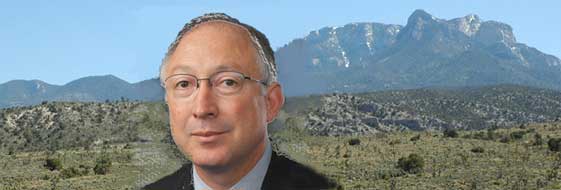
Copenhagen, Denmark – Today, US Secretary of the Interior delivered the keynote address entitled “New Energy Future: The Role of Public Lands in Clean Energy Production and Carbon Capture” at the UN Conference on Climate Change. Here are some quotes:
"The American continent saw great change in those four centuries. The Pilgrims set foot at Plymouth Rock. The United States declared its independence. And the borders of a growing nation swept westward over my family’s lands. Through all the changes my family has witnessed, some things have been constant: the waters that irrigate our crops;
the snows in the Sangre de Cristo Mountains; the birds that migrate through the San Luis Valley. My parents taught me and my seven brothers and sisters that these blessings do not come free. They taught us that we must serve as stewards of the land, water, and wildlife that sustains us, season after season.
"Yet today, humankind is at risk of breaking this sacred trust. Carbon pollution is putting our world – and our way of life – in peril. The places we love… the resources on which we rely… the peoples of the world who are most vulnerable… are all at risk if we do not act."
"...As we stand up the new energy frontier and bring down our carbon emissions, America’s lands and oceans can serve as clean energy producers. They can serve as carbon catchers....On renewable energy: the truth is - until now - America’s vast deserts, plains, forests and oceans have been largely unexplored for their vast clean energy potential. ...We have huge solar potential in the deserts of the Southwest, including near Los Angeles and Las Vegas."
"...We’ve been busy over the last year finding ways to develop the renewable energy potential on public lands in an environmentally responsible manner...we are moving quickly as well. We are opening Renewable Energy Coordination Offices in western states
to help swiftly complete reviews on the most ready-to-go solar, wind, geothermal, and related transmission projects on public lands."
"...We have set aside 1,000 square miles of public lands in twenty-four “Solar Energy Study Areas” that the Department of the Interior is evaluating for environmentally appropriate solar energy development across the West.
And we have invested $41 million through the President’s economic recovery plan to facilitate a rapid and responsible move to large-scale production of renewables on public lands."
"...To get this clean power to market, we are upgrading America’s transmission grid for the 21st century. We are clearing out red tape [you mean environmental review laws?] at the federal level, identifying transmission corridors that can move power from where it’s produced to where it’s consumed, and fast-tracking approximately 1,000 miles of new transmission projects that can get under way by the end of 2010."
"...It is well known that plants and soils drink carbon out of the air. And we know that changes to land management patterns, changes to vegetation, and deforestation can all limit the land’s ability to soak up carbon. In the U.S., for example, we are losing 3 million acres a year to development – an area the size of Connecticut. To understand the carbon impacts of these changes to the land, we need better tools to measure how much carbon is being absorbed on our landscapes, and to predict how different management practices would affect carbon absorption."
This is laughable when thousands of acres of carbon-storing desert vegetation and soils are slated to be graded and scraped to make way for solar projects.
"Interior’s science agency, the United States Geological Survey, has been working to develop these very tools. Today, I’m proud to announce that the USGS has completed an important first phase of work on its biological carbon sequestration assessment. In collaboration with scientists from the Department of Agriculture, they have found that
plants and soils in the lower 48 states store almost 90 billion metric tons of carbon – or the equivalent of around 50 years of U.S. carbon dioxide emissions at current levels. All together, terrestrial ecosystems in the U.S. are soaking up carbon equivalent to about 30% of U.S. fossil fuel CO2 emissions."
On climate adaptation: "Since January, we at the Department of the Interior have built a coordinated strategy for managing the impacts of climate change on our land, water, marine, fish and wildlife, cultural heritage and tribal resources. We recognize that effects of climate change aren’t limited to any one national park, wildlife refuge, or Indian
reservation – they are felt over broad landscapes. Entire wildlife corridors are changing. Shifting precipitation patterns are being felt up and down the seven-state Colorado River basin. And rising sea levels are affecting communities along all coasts. That’s why the Department of the Interior’s climate change adaptation strategy is organized around landscape-scale partnerships. Eight DOI Climate Change Response Centers will synthesize existing climate change impact data and management strategies, help resource managers put them into action on the ground, and engage the public through education
initiatives. And across the United States, we are standing up a network of Landscape Conservation Cooperatives that – together with other federal agencies, local and state partners, and the public - will craft practical, landscape-level strategies for managing climate change impacts. Working with Climate Change Response Centers, the cooperatives will focus on impacts that typically extend beyond the borders of any single National Wildlife Refuge, BLM unit, or National Park, including invasive species, fire, drought, wildlife, and changing water supplies. We know that no one government or no one landowner alone can solve these problems."
 Again, the hypocrisy of covering 1,000 square miles of desert habitat with fenced blocks for solar plants, which will be barriers to wildlife movment and migration during climate change, is astounding. The Solar 1 project alone will block 8,000 acres of Desert bighorn sheep, tortoise, and Fringe-toed lizard movement corridors, and the cumulative impacts of the other projects planned for the area will surely take a large toll on animal life in that part of the Mojave Desert. These issues are simply not being considered by Salazar in his rush to extract new resources.
Again, the hypocrisy of covering 1,000 square miles of desert habitat with fenced blocks for solar plants, which will be barriers to wildlife movment and migration during climate change, is astounding. The Solar 1 project alone will block 8,000 acres of Desert bighorn sheep, tortoise, and Fringe-toed lizard movement corridors, and the cumulative impacts of the other projects planned for the area will surely take a large toll on animal life in that part of the Mojave Desert. These issues are simply not being considered by Salazar in his rush to extract new resources.
Researchers at the University of California at Santa Barbara found that "climate change impacts to species connectivity can be compounded by renewable energy developments, which decrease core and highly suitable habitat and can act as major obstacles to migration and gene flow. To help maintain connectivity within the West Mojave, renewable energy planners can reconsider developing projects within critical or highly suitable habitat, within connectivity pathways, and surrounding important source populations and
climate refugia for the bighorn sheep metapopulation" (Cumulative Impacts of Large-scale
Renewable Energy Development in the West Mojave: Effects on habitat quality, physical movement of species, and gene flow, 2009, Lucas Bare, Tessa Bernhardt, Toby Chu, Melissa Gomez, Christopher Noddings, Milena Viljoen, A Group Project submitted in partial satisfaction of the requirements for the degree of Master of Environmental Science and Management at the Donald Bren School of Environmental Science and Management, pdf >>here). Figures below from this paper:
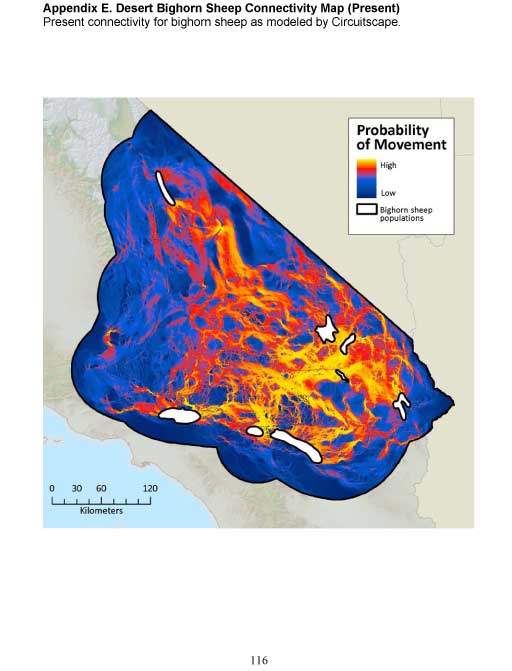
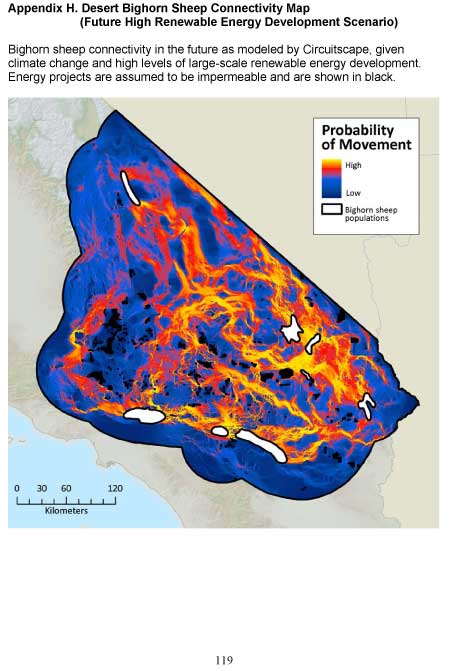
Parks and certain protected areas may be preserved in this massive scheme: "We can’t afford to let these lands disappear. Through the use of landscape and seascape-level conservation initiatives, we will strengthen the connectivity and resiliency of our parks and protected areas and the wildlife and ecosystem services they support. These efforts will prove critical. We have come a long way in the last year. Across America, the seeds of the clean energy economy have been sown in the soils of our lands, the minds of our engineers, and the imagination of our citizens."
We note that protected Desert tortoise critical habitat and Areas of Critical Environmental Concern in California do not seem to qualify (sse the Daggett Ridge Wind proposal >>below).
"Clean energy legislation will trigger a massive new investment in renewable energy, energy efficiency, and carbon capture and sequestration technologies. It will level the playing field for new technologies by putting a price on carbon through pollution limits. And it will send the signal to industry and the world that the United States will be a partner in
tackling climate change."
Read: all electricity prices will go up for ratepayers so that inefficient solar and wind can be raised up to compete with coal and natural gas by government hand-outs to companies. We ask, where are the big federal government incentives to individuals to retrofit all homes with rooftop solar panels and increase efficiency in cities?
Department of Interior News Release >>here.
Decmber 10, 200
LA Times: John Muir Was a NIMBY
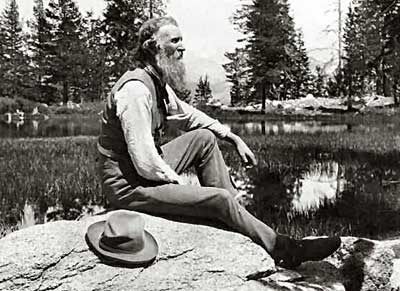 Judith Lewis, contributing editor to High Country News, wrote a great opnion piece about how the much-maligned "Not In My Backyard" folks have good historical precedents.
Judith Lewis, contributing editor to High Country News, wrote a great opnion piece about how the much-maligned "Not In My Backyard" folks have good historical precedents.
Donna and Larry Charpied just won an appeal in court to halt the huge garbage dump next to their jojoba farm in Chuckwalla Valley, on the border of Joshua Tree National Park. But now they have to fight even larger solar industrial developments in the same areas. "The Charpieds maintain there are better places for solar panels, such as urban rooftops. They have little faith that the renewable-energy boom will do more than industrialize the desert for short-term profit."
The term NIMBY has been used to denigrate "people who put their own neighborhoods ahead of the greater good, or who don't mind creating pollution as long as they don't have to breathe it."
"But to denigrate every expression of NIMBYism as hypocritical is to forget the long history of wilderness protection in this country. The truth is, we have NIMBYs to thank for nearly all of our wilderness treasures. Sigurd F. Olson fought for Minnesota's Boundary Waters while working as a wilderness guide in that vast, watery woods; John Muir launched his campaign for Yosemite after living there for a summer herding sheep. No one would call Olson and Muir NIMBYs today, but that's what they were: They directed the public's attention to the beautiful landscapes near where they lived, and fought to protect those places from the ravages of industry."
Opinion in the Los Angeles Times >>here.
December 10, 2009
Daggett Ridge Wind Farm Proposed in Critical Habitat
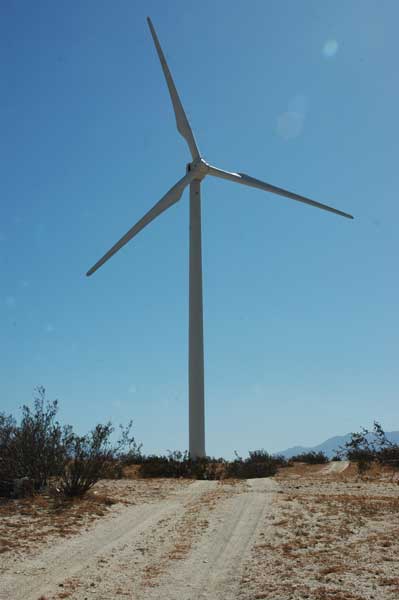
The proposed Daggett Ridge Wind generation Project by the company AES Wind Generation would be situated in the Ord-Rodman Desert Wildlife Management Area, critical habitat for a dense population of Desert tortoises, a federally threatened species. It would also be in the Monkey Flower Area of Critical Environmental Concern. These areas are in low mountain ranges in the Mojave Desert of California.
Apparently all important ecological areas are going to be opened to energy development. Will parks be next?
The Bureau of Land Management (BLM) 11/23/09 published a Notice of Intent (NOI) to conduct an environmental review on the impacts of a proposed wind generation energy project, Daggett Ridge Wind Farm Wind Generation Project, in San Bernardino County. AES Wind Generation has applied to the BLM for a right-of-way on public lands to construct a 82.5 megawatt (MW) wind generation power plant facility on approximately 1,957 acres. Approximately 1,577 acres would be on public land managed by the BLM. Approximately 380 acres would be on private land owned by AES Wind Generation.
The project site is southeast of Barstow and southwest of the town of Daggett.
The BLM, as the lead agency under the National Environmental Policy Act, and San Bernardino County, as the lead agency under the California Environmental Quality Act, will jointly prepare an environmental impact statement/environmental impact report to analyze the site-specific impacts of the proposed project including a proposed amendment to the California Desert Conservation Area Plan.
The document will analyze air quality; biological, cultural, water, geological, and visual resources; hazardous material handling; noise; transmission system engineering and transmission line safety. Publication of the NOI starts a public scoping period of 30 days, ending December 23, 2009. During the scoping period, the public is invited to identify and comment on concerns, issues, potential impacts, alternatives and mitigation measures that should be considered.
A scoping meeting is scheduled for Wednesday, December 16, 2009 at the Barstow Unified School District Staff Development Center, 551 South Avenue H, Barstow, CA from 6:30 p.m. to 8:30 p.m. BLM will use the comments received to prepare the draft environmental documents to be available for public review at a later date.
Further details on the proposed wind energy project can be found at: http://www.ca.blm.gov/barstow. For information contact Lynnette Elser at 951-697-5233, or email cadaggettridge@blm.gov.
November 23, 2009
First Solar Sells Blythe Photovoltaic Field Plant to NRG
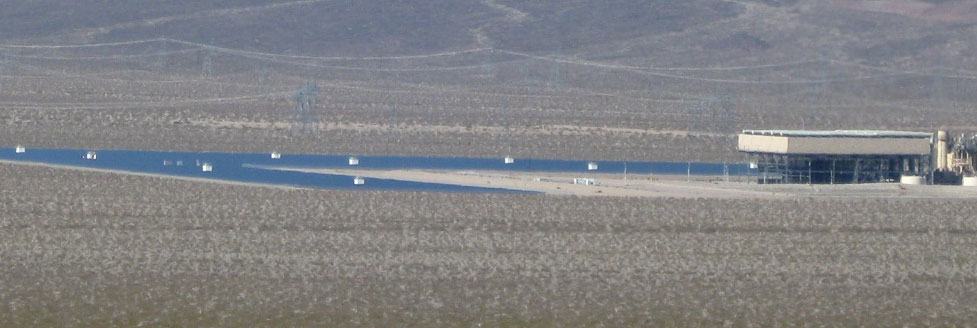
^Sempra photovoltaic power plant in Boulder City, Nevada, built by First Solar.
Solar panel manufacturer First Solar Inc. of Tempe, Arizona, is selling its 21-megawatt Blythe photovoltaic power plant, which would be California's largest to independent power producer NRG Energy Inc. of New Jersey, one of the largest U.S. independent power-plant operators of fossil fuel and nuclear power plants.
Edison International's electric utility will purchase the output from the facility, in Riverside County southeast of Los Angeles, under a 20-year contract.
NRG has also invested $10 million in solar-thermal power developer eSolar Inc. and started work on two solar-thermal power plants in California and one in New Mexico. Utilities owned by Edison, PG&E Corp. and El Paso Electric Co. have signed contracts for the output from those plants.
"Our business model is not to be a long-term owner and operator, but rather to find investors who would take at least a vast majority of equity in projects," said First Solar spokesman Alan Bernheimer.
First Solar built the 10-megawatt solar farm in Boulder City, Nev., for Sempra Energy , and is working on a second, 48-megawatt facility nearby. Pacific Gas & Electric Co. has agreed to buy the output from both projects under long-term contracts.
Story in the Wall Street Journal >>here.
November 16, 2009
UC Riverside Botanist Discusses Loss of Biodiversity if Solar Plants Built
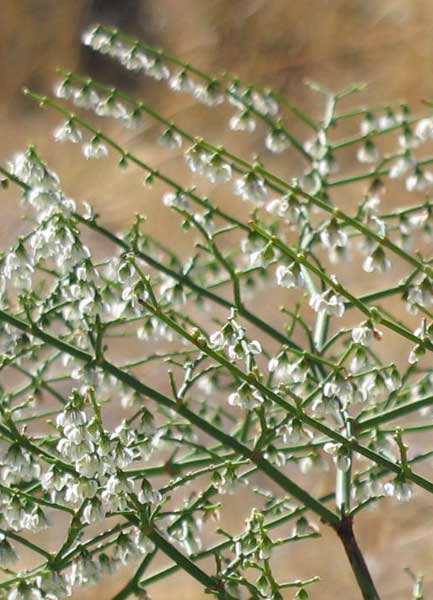
<Flat-top buckwheat (Eriogonum brachypodum); new species of this genus have recently been discovered in the Mojave Desert.
Jim Andre, botanist and director of University of California at Riverside's Sweeney Granite Mountains Desert Research Center in the Mojave National Preserve, is concerned that the land rush to develop solar and wind projects in the California desert will destroy rare plants. Not only that, but plants that are not even known to science yet. He estimated more than a hundred plants may still be undiscovered in the desert, species new to science that await description. He pointed out a new buckwheat (Eriogonum) found recently on a small part of the Bristol Mountains.
Andre says the magnitude and timeframe of the projects threaten one of the country's last intact and viable ecosystems that has anhuge biodiversity: 37 % of California plant species are found in the desert.
Many botanists question whether society understands the ramifications of making the remote deserts a giant industrial-energy zone instead of starting with rooftops and previously disturbed land, such as abandoned farms.
Story in the San Bernardino Press-Enterprise >>here.
November 14, 2009
Ely Looking at Nuclear Plant
After two large coal plants were nixed in northeastern Nevada, some in Ely are eyeing bringing a nulcear power plant into the area to boost jobs. Advocates now claim nuclear energy is “green" because it does not emit greenhouse gases. Mike McGough, senior vice president of UniStar Nuclear Energy, made an informational presentation on nuclear development in Ely this past October.
Ely Mayor Jon Hickman, who is advocating for the nuclear plant, thinks there would be enough water to cool the plant, but many are skeptical.
The water in the Steptoe Valley basin, which covers the area of White Pine County that includes Ely and the outlying area where the nuclear plant might be located, is taken according to state records. Farmers, miners, and municipalities pump about 70,000 acre-feet of water from beneath the ground each year. Locals have permission from the state to pump more than 96,400 acre-feet of water a year. Most water rights holders don’t use all their water every year, and the biggest users are farms, where much of the water used soaks back down into the aquifer.
Modern nuclear power plants use about 25 million gallons of water a day. Annually, that comes out to about 60,000 acre-feet of water. Most plants have recapture technology that can lower that number to 25,000 acre-feet. But that’s still 36 percent of the basin’s water.
Story in the Las Vegas Sun >>here.
November 9, 2009
Nevada Coal Plant to Qualify for Renewable Energy Credit?
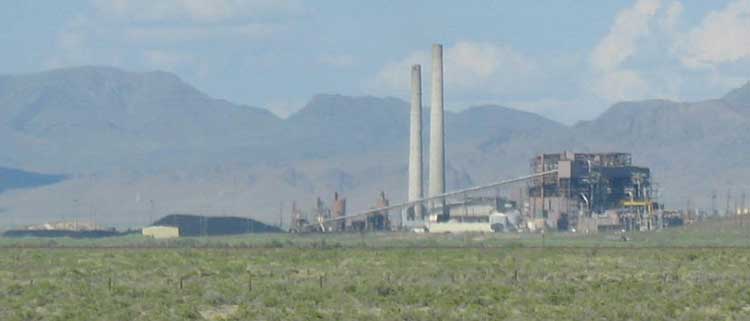
NV Energy is hoping to mix wood chips into the coal burned at Reid Gardner coal plant near Moapa, about 50 miles northeast of Las Vegas, hoping to qualify the power plant for a renewable energy credit.
Wood qualifies as biomass fuel, and the test is burning 5% wood chips into the coal. The wood is "scrap" trucked from a burn on Kaibab National Forest in northern Arizona 150 miles away.
Story in the Las vegas Sun >>here.
October 22, 2009
Solar Millennium Gets Big Investor Backing
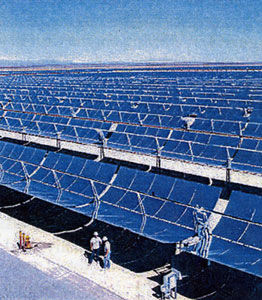 Solar Millennium AG now has agreements to secure financing with Citigroup and Deutsche Bank for solar thermal parabolic trough plants in Ridgecrest, Palen, and Blythe, in the California Desert. The Solar Millennium Group already has power purchase agreements in place with Southern California Edison (SCE) for two of these. The company has also concluded a Memorandum of Understanding with Nevada Energy for the development of at least one solar thermal power plant in the Amargosa Desert.
Solar Millennium AG now has agreements to secure financing with Citigroup and Deutsche Bank for solar thermal parabolic trough plants in Ridgecrest, Palen, and Blythe, in the California Desert. The Solar Millennium Group already has power purchase agreements in place with Southern California Edison (SCE) for two of these. The company has also concluded a Memorandum of Understanding with Nevada Energy for the development of at least one solar thermal power plant in the Amargosa Desert.
Each project has an expected financing volume of more than US $1 billion.
Together with Solar Trust of America, Solar Millennium's U.S. subsidiary, Citigroup and Deutsche Bank are structuring the debt and equity financing and providing support in securing subsidies and loan guarantees granted by the Department of Energy through the American Recovery and Reinvestment Act.
“The fact that these two globally renowned banks are involved in financing our projects is an important factor of success in their implementation. We have thus moved one step closer to their realization. The next task is to attempt integrating government subsidies and guarantees in the financing structure,” said Thomas Mayer, CFO of Solar Millennium.
Story from RenewableEnergyWorld.com >>here
October 12, 2009
Salazar Plans to Expedite Renewables on California Desert

Secretary of the Interior Ken Salazar and Bureau of Land Management Director Bob Abbey on October 9 officially opened a California Renewable Energy Coordination Office (RECO), one of several Interior initiatives to expedite the leasing and production of renewable energy resources on public lands in the West.
Other offices will open in Nevada, Arizona and Wyoming, along with renewable permitting teams in six other western states, to swiftly complete application reviews on solar, wind, geothermal, and transmission projects on public lands. Currently BLM has received about 500 renewable energy project applications and the submissions are growing.
“With coordinated environmental studies, good land-use planning and zoning and priority processing, we can accelerate responsible renewable energy production and lay the foundation for a clean-energy economy for the 21st century,” Salazar said.
The RECO Program Manager in the California office will be Greg Miller, a 21-year veteran of the BLM who began his career as a Wildlife Biologist and now manages the renewable energy program for the California Desert District. He will lead a staff of 12 to 15 specialists at two BLM locations -- Palm Springs and Moreno Valley.
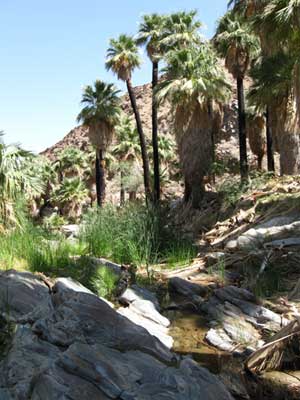 As virtual offices, the RECO staffers are located in different BLM offices within each state, working together through coordinated structures and leadership to speed all aspects of the application and permitting process. To lead the overall initiative, Salazar has established a National Renewable Energy Office at BLM’s Headquarters in Washington D.C. which includes a Renewable Energy Team Leader and a Program Manager for each of the renewable energy and transmission programs.
As virtual offices, the RECO staffers are located in different BLM offices within each state, working together through coordinated structures and leadership to speed all aspects of the application and permitting process. To lead the overall initiative, Salazar has established a National Renewable Energy Office at BLM’s Headquarters in Washington D.C. which includes a Renewable Energy Team Leader and a Program Manager for each of the renewable energy and transmission programs.
The four Renewable Energy Coordinating Offices have identified 62 positions that will be filled with reassignments or new selections to support the processing of renewable energy and transmission applications. Thirty-five additional renewable energy support staff have been identified for the BLM renewable permitting teams in the six western states of Colorado, Idaho, Montana, New Mexico , Oregon, and Utah.
On October 12 Salazar and California Governor Arnold Schwarzenegger signed what they called “a model of federal-state initiative and cooperation” to use expedited review and processing and Recovery Act funding to spur the development of "environmentally appropriate" renewable energy on U.S. lands in California.
Among its major provisions, the agreement will:
- Establish a Renewable Energy Policy Group of senior policy representatives from Department of Interior, the Governor's office, and the California Natural Resources Agency, to guide the cooperative work. A "Renewable Energy Action Team" (REAT), made up of US Fish and Wildlife Service, Cal. Dep. of Fish and Game, California Energy Commission, Bureau of Land Management, and the California Natural Resources Agency, would prepare a "conservation strategy" by December 31, 2009: it would identify Renewable Energy Zones (REZs), as well as regional multispecies and habitat conservation plans. Input would supposedly be sought from "environmental groups and wildlife organizations" [we've heard this before...], as well as energy developers. Mitigation incentives and maps would be developed.
- Develop a strategy to identify areas suitable and acceptable for renewable energy
development. [Will this include the public, we wonder?] - Identify renewable energy zones based on renewable energy development potential and environmental, wildlife, and conservation criteria. [The latter criteria have been largely ignored so far, we believe.]
- Prioritize application processing for solar development in renewable energy zones. [such as Solar Energy Study Areas >>here]
- Coordinate with federal and state agencies to identify energy and transmission needs and opportunities and designate transmission needs and corridors.
Through the American Recovery and Reinvestment Act of 2009, the President and Congress have made $41 million available to facilitate a rapid and responsible move to large-scale production of renewables on public lands. The Act directs economic stimulus funding to qualified renewable energy projects that begin construction by December 1, 2010.
As part of the Memorandum of Understanding (pdf >>here), Interior and state agencies will not only expedite the siting, permitting, and processing of renewable energy projects but also develop a timeline that provides applicants for these projects with permitting schedules required to meet the recovery act’s December 1, 2010 deadline for beginning construction.
Salazar’s Secretarial Order 3285, one of his first directives at Interior, makes the production, development, and delivery of renewable energy one of the Department’s highest priorities and directs Interior agencies to work collaboratively with other federal agencies States, local communities and private landowners to encourage the development of renewable energy and associated transmission.
The Memorandum of Understanding directs the California Department of Fish and Game (DFG), U.S. Fish and Wildlife Service (US FWS), California Energy Commission (CEC), and the Bureau of Land Management (BLM) to commit resources and staff to help fast-track permits.
Under the Desert Renewable Energy Conservation Plan (DRECP) Cal. Fish and Game and US FWS will help identify the "best" areas to site renewable energy, while avoiding conflicts with endangered species and sensitive areas (a tight-rope walk, no doubt).
Highest priority would be given to areas with transmission lines already present, as well as to Solar Energy Study Areas developed under the Solar Programmatic Environmental Impact Statement of BLM (see the website for this >>here), in addition to the Renewable Energy Transmission Initiative (RETI)(see website >>here). Apparently, Renewable Energy Zones developed under DRECP would be a further set of land areas which would be prioritized for renewables. All would be coordinated.
Two Levels of Renewable Maps in California:
1. Solar PEIS - Solar Energy Study Areas (Bureau of Land Management)
2. DRECP with NCCPs (Cal. Dep. Fish and Game)
A draft DRECP would be put out by December 31, 2010, beginning an environmental review process finalized by June 30, 2012.
Transmission corridors would be identified and designated "to facilitate development of renewable energy resources" by December 2010. High priority would be given to transmission lines going to Solar Energy Study Areas and REZs.
Desert Renewable Energy Conservation Plan
Salazar and Schwarzenegger are trying to streamline the permitting process for renewable energy development in the Mojave and Colorado Desert regions, especially when it comes to protected species. DFG and CEC are directed to develop a Desert Renewable Energy Conservation Plan (DRECP), initiated in November 2008 by a Governor's executive order, to identify areas for renewable energy project development and areas intended for long-term conservation. The DRECP will provide long-term endangered species permit assurances to developers and facilitate approval of desert projects. The presence of protected species and habitat has been one of the biggest "obstacles" that projects have had to deal with, but the DRECP will potentially take that contentious element out.
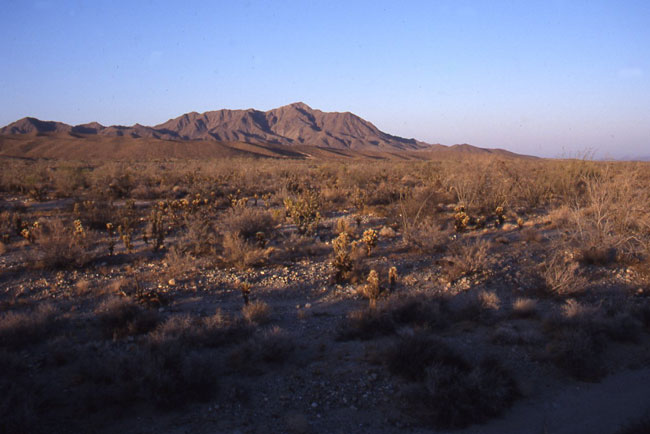 It would develop a multispecies conservation strategy to streamline compliance with all applicable state and federal laws including the California Endangered Species Act, the federal Endangered Species Act of 1973, and the Federal Land Policy and Management Act (FLPMA) of 1976.
It would develop a multispecies conservation strategy to streamline compliance with all applicable state and federal laws including the California Endangered Species Act, the federal Endangered Species Act of 1973, and the Federal Land Policy and Management Act (FLPMA) of 1976.
Natural Community Conservation Planning (NCCP) program, "identifies and provides for the regional or area wide protection of plants, animals, and their habitats, while allowingcompatible and appropriate economic activity," according to DFG. Many applicants can be accommodated in such "ecosystem-wide" plans. An NCCP permit can last 50 years. One of the first was the Coachella Valley Multiple Species Habitat Conservation Plan.
Acquisition and preservation actions would be funded by applicants with contributions from state and federal government.
Will mitigation money from renewable energy developers be funneled into visitor centers and new GPS devices for research projects? Environmentalists will want land to save species. Clark County's multispecies habitat conservation plan had to set aside hundreds of thousands of acres for species conservation while the rest went to urban sprawl. This will be more difficult to accomplish in California over a widespread desert.
Current focus of the DRECP is on the desert; future development of NCCPs for renewable projects will focus on the Modoc Plateau and the Carrizo Plain. Initial planning for a NCCP is underway for the Altamont Pass Wind Resource Area.
CEC in a pdf presentation says the plan will overcome "multi-agency culture and process impediments to create a seamless and integrated permitting process." To us this looks like top-heavy planning. Getting BLM, DFG, and other agencies to give in to a "one-stop shop" has not worked smoothly. CEC was supposed to have done this already. And the public may not simply lie down and allow their comments to be ignored.
See California Department of Fish and Game Natural Community Conservation Planning (NCCP).
From Department of Interior News: http://www.doi.gov/news/09_News_Releases/100909c.html
and http://www.doi.gov/news/09_News_Releases/101209.html
California Native Plant Society has a good summary, and comments on the DRECP.
